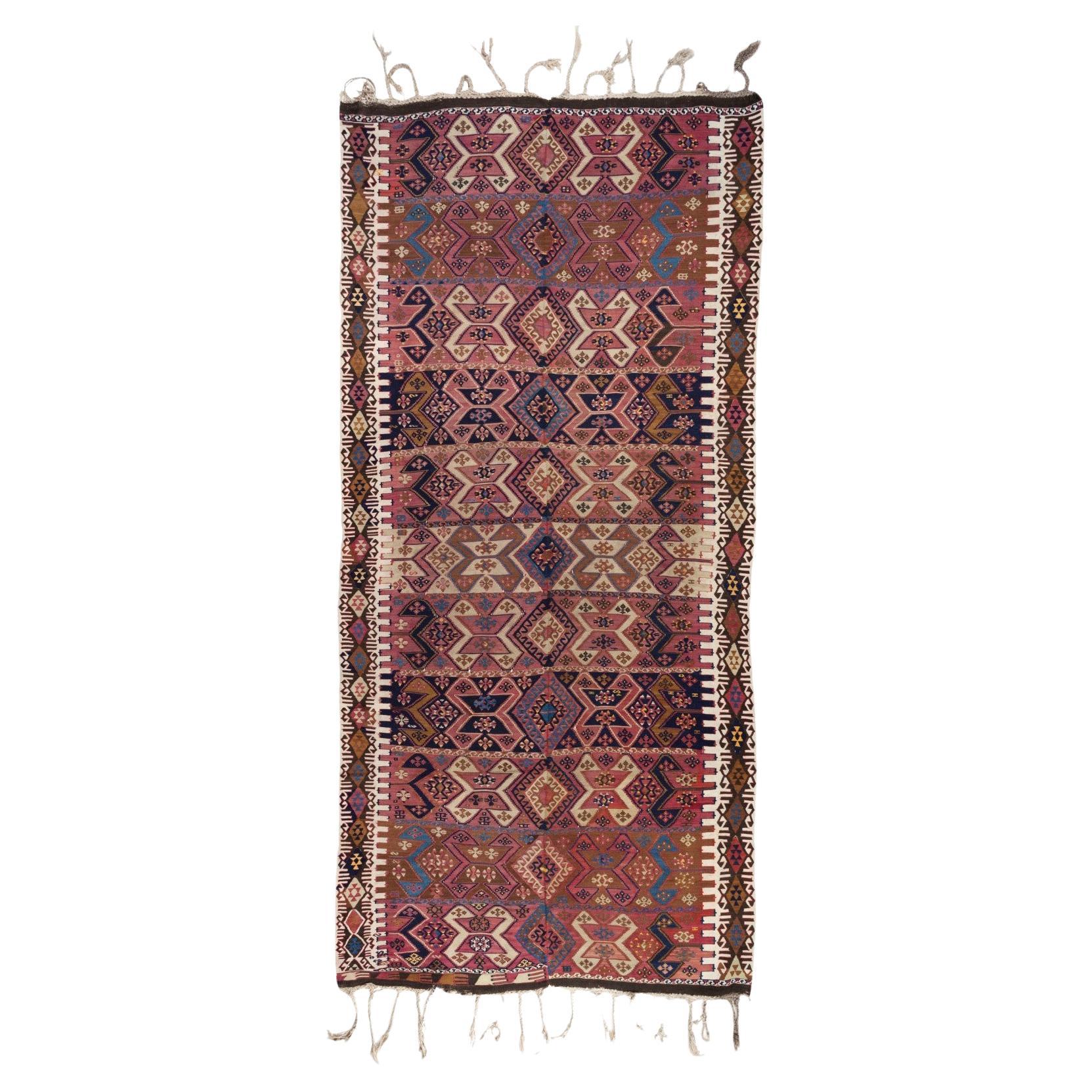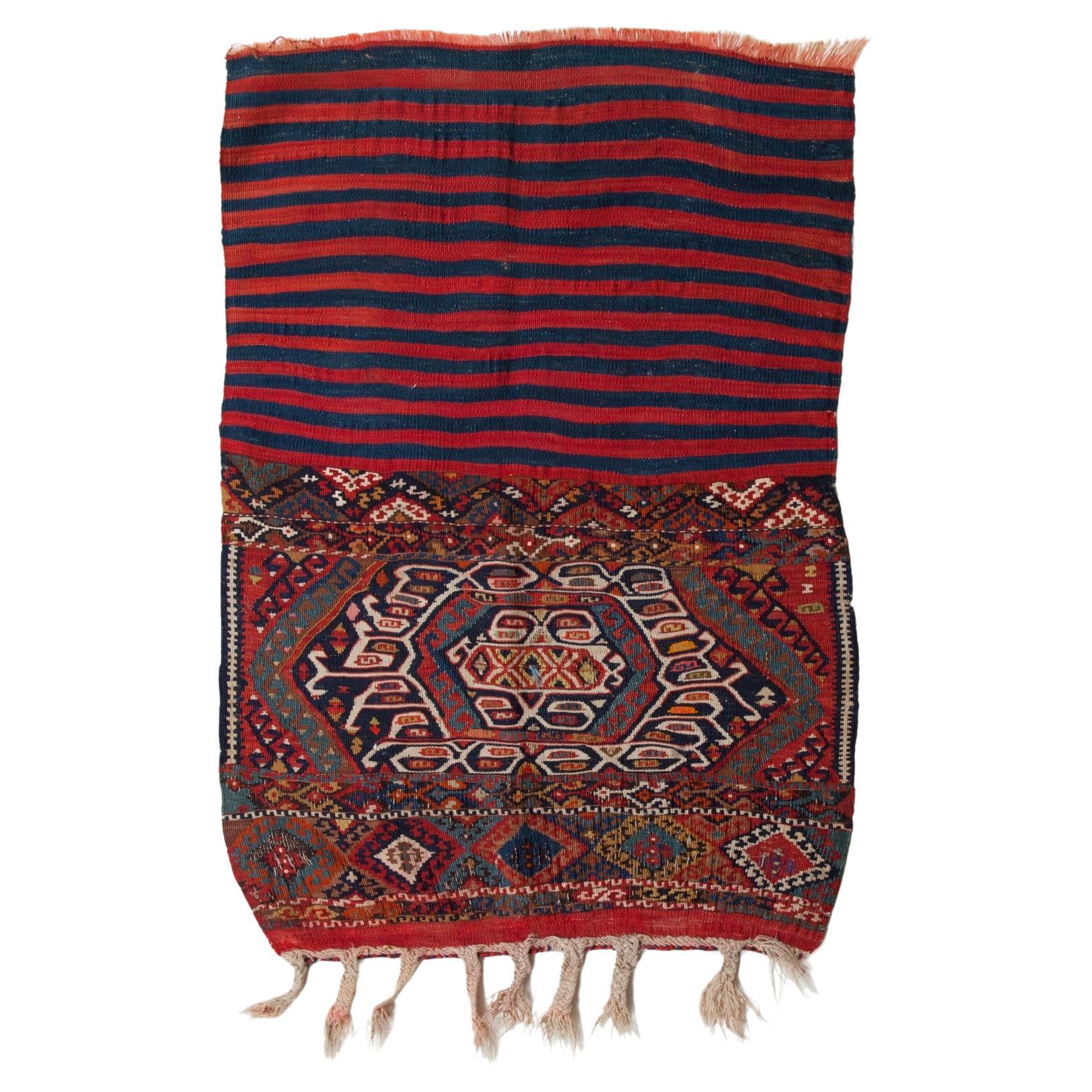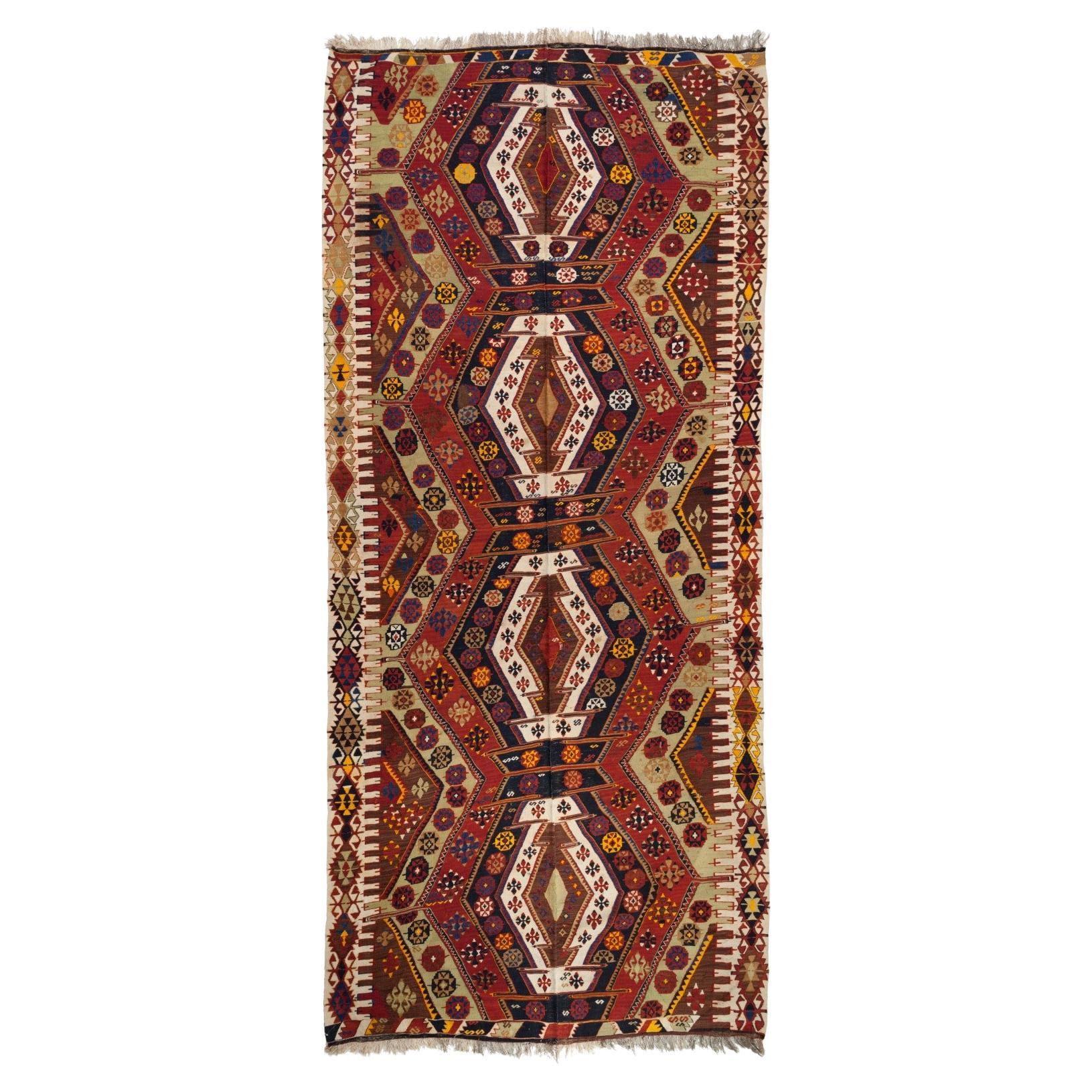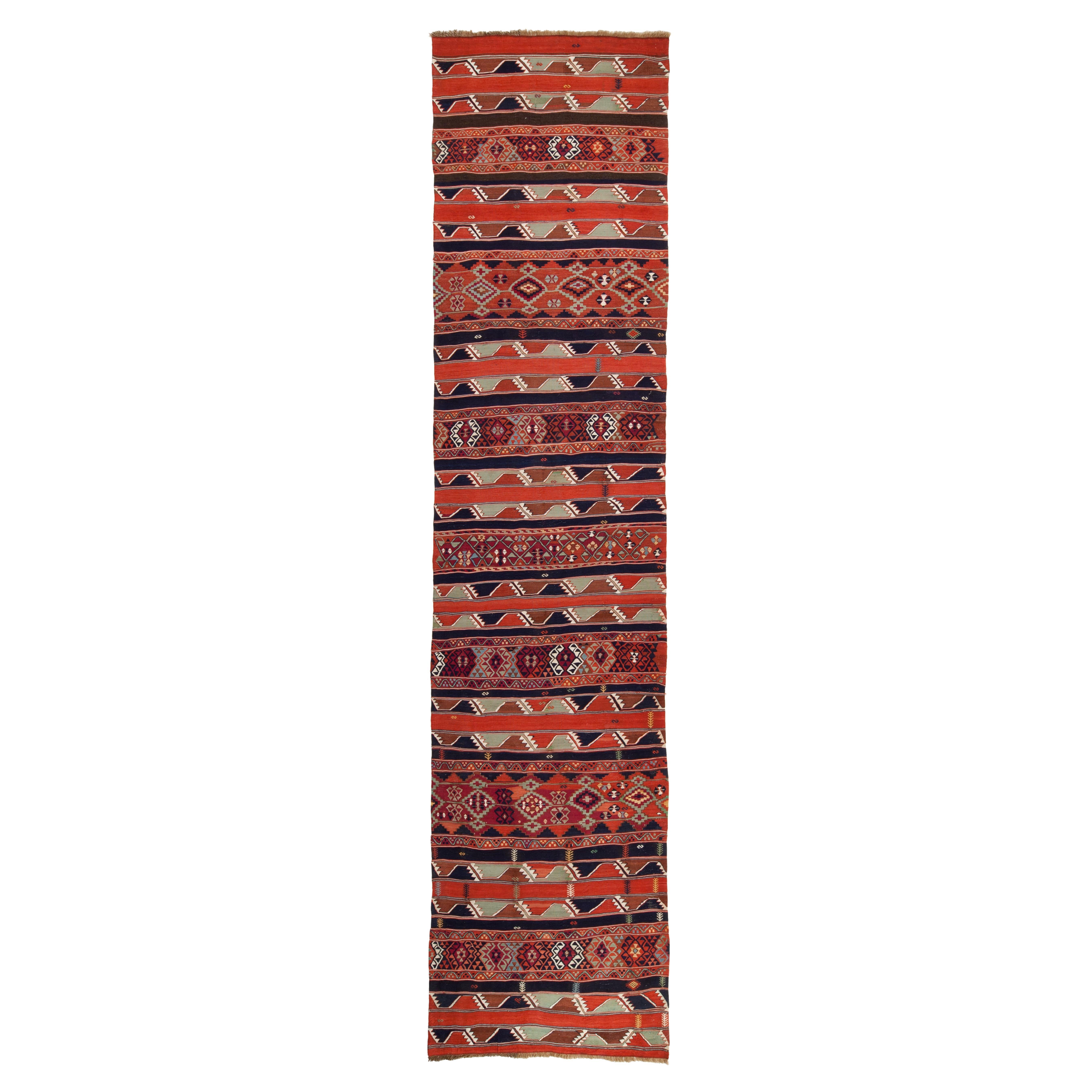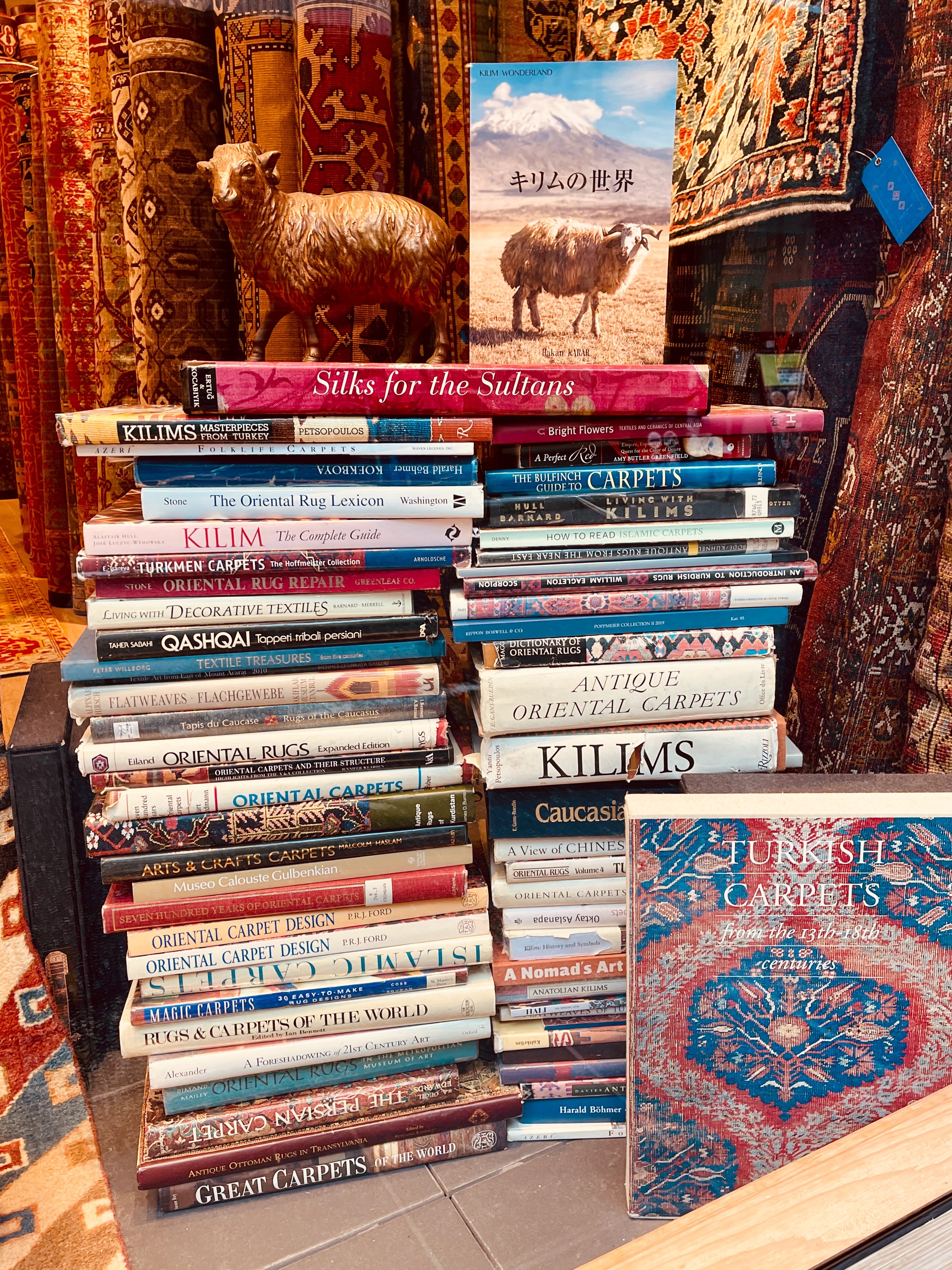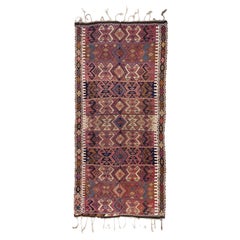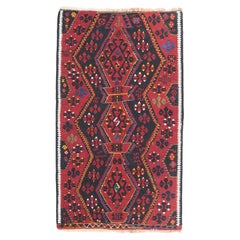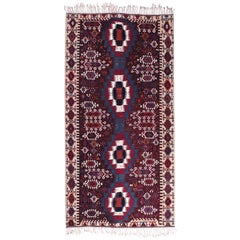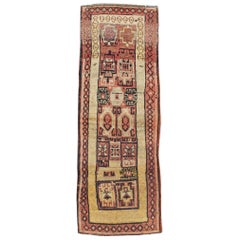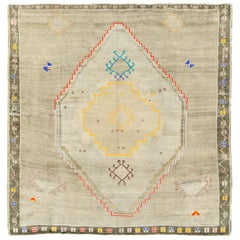Items Similar to Antique Malatya Kilim South Eastern Anatolian Rug Turkish Carpet
Want more images or videos?
Request additional images or videos from the seller
1 of 7
Antique Malatya Kilim South Eastern Anatolian Rug Turkish Carpet
About the Item
This is a Southern Anatolian Antique Kilim from the Malatya region with a rare and beautiful color composition.
This kilim is listed in the book; Kilims Flat-woven Tapestry Rugs, Yanni Petsopoulos, 1979 Rizzoli New York, plate nr. 241.
The brocaded bands cross the entire width of the field forming panels contained within very narrow borders. Their decoration consists of a series of alternating large and small concentric hooked lozenges.
Malatya is a town built on one main street that continues for several miles. It is situated in the Tohmasuyu River basin which is encircled by the high peaks of the eastern Taurus Mountains. This is a fertile agricultural region, particularly for apricots, and has been a prolific weaving area for many years. The modern town was established in 1838; old Malatya, which is close by, was once an important city in Armenia Minor. In Roman times it was important as a garrison town on the eastern frontier, and the settlement came under Ottoman rule in the early fifteenth century. Considering the number of kilims woven in this region there is a surprising lack of diversity in design, especially in the larger kilims; this is possibly a direct result of the Kurdish tribal tradition of weaving only one type of design. Small prayer rugs are more varied and often have great character and individuality. The quality of the kilims now woven in the region is deteriorating, and production for commercial purposes is slowly spreading into the villages. Large kilims generally feature three or four central medallions, while the smaller variety is usually decorated with one in the center. Some of these kilims have been referred to as 'Rashwan' weavings. The Rashwan was a Kurdish tribe that settled in parts of central and eastern Anatolia. These kilims are not easy to weave, for the designs are complicated and the filler motifs plentiful; indeed, their value has probably been underestimated by the market. Another variety of medallion kilim is also found in a smaller size and features a hexagonally shaped medallion with arms or hooks extending from the sides. This is used as a central motif arranged in a vertical line for smaller kilims, and for larger sizes, it is repeated in rows down the field. Such a motif is also found in Aksaray and Aleppo kilims, which have a lighter color palette. Banded kilims are borderless, and patterned with both narrow and wide alternating stripes. These are decorated with small motifs, often in supplementary weft-wrapping technique, and separated either by smaller patterned bands or by a plain color. Large sizes are made in two halves. As in other Kurdish weavings, a dark color palette of red, blue, brown, and some green is used that contrasts with undyed wool or bright white cotton. The wool is of good quality and lustrous, and sometimes very finely spun. Weaving techniques vary a great deal; some kilims incorporate both plain-weave and supplementary weft wrapping, although slit-weave is predominantly used. The fringes of Malatya kilims are sometimes plaited. Many different sizes are found - large kilims, generally woven in two halves, small kilims, yastiks (cushions), and çuval (sacks).
- Dimensions:Width: 63.78 in (162 cm)Length: 130.32 in (331 cm)
- Style:Kilim (In the Style Of)
- Materials and Techniques:
- Place of Origin:
- Period:
- Date of Manufacture:circa 1900s
- Condition:Repaired: Minor repairs, with antique natural dyed wool threads by our repair specialists. Wear consistent with age and use. Minor fading.
- Seller Location:Tokyo, JP
- Reference Number:Seller: 270371stDibs: LU8206233562372
ARARAT RUGS
We know and believe that the geography we come from, our past, and our lifestyle are the most important bond between us to carry the oriental carpet art and culture to the next generations along with our core values in our ongoing growth journey.
We are aware that the way to achieve this goal and carry this priceless art and culture to the future depends on a lot of work with all our people every day while adhering to our core values.
For us, art is meaningful in the sense that it brings together various cultures around the world. It is an honor for us that oriental carpet art and culture have been instrumental in this for centuries and that we are a part of this business.
We are tirelessly keeping an eye on auction house information around the world about carpets. New York's Metropolitan, London's Victoria & Albert Museums, and other famous art museums, as well as small specialized museums that house private collections, and books about oriental carpets to collect information on outstanding carpet designs and patterns from around the world. It's our Self-improving and Self-developing culture.
As Turkish Culture of Hospitality, the Kurdish Culture of Generosity, and as Japanese Culture of Business Punctuality; are the most important values that this multicultural background has taught and bequeathed to us. It is essential and valuable for us that you feel this feeling not only by looking at our oriental carpets but from the moment you contact us.
About the Seller
5.0
Platinum Seller
Premium sellers with a 4.7+ rating and 24-hour response times
Established in 1970
1stDibs seller since 2023
42 sales on 1stDibs
Typical response time: 2 hours
- ShippingRetrieving quote...Shipping from: Tokyo, Japan
- Return Policy
Authenticity Guarantee
In the unlikely event there’s an issue with an item’s authenticity, contact us within 1 year for a full refund. DetailsMoney-Back Guarantee
If your item is not as described, is damaged in transit, or does not arrive, contact us within 7 days for a full refund. Details24-Hour Cancellation
You have a 24-hour grace period in which to reconsider your purchase, with no questions asked.Vetted Professional Sellers
Our world-class sellers must adhere to strict standards for service and quality, maintaining the integrity of our listings.Price-Match Guarantee
If you find that a seller listed the same item for a lower price elsewhere, we’ll match it.Trusted Global Delivery
Our best-in-class carrier network provides specialized shipping options worldwide, including custom delivery.More From This Seller
View AllAntique Malatya Kilim Rug Old South Eastern Anatolian Turkish Carpet
Located in Tokyo, JP
This is a South Eastern Anatolian antique Kilim from the Malatya region with a rare and beautiful color composition.
Malatya is Turkey's main kilim production area, and there are many variations. This is one of them, a runner-type kilim. The thread is thin, and the weave is very fine and dense. Some metallic threads are used in this antique kilim, which is rarely seen in Anatolian kilims. Red, navy blue, and gray are the colors that determine the impression of this kilim. Other colors, such as brown, yellow, and light blue, are also used in the patterns. The wavy horizontal striped pattern, plain pattern, and lined motif pattern are woven together to create a kilim that looks like an obi.
The pattern of the motif and the pattern of the wave are about the same amounts, giving a lively impression without getting busy. The deep shades of colors and patterns that are familiar to each other are unique to antiques. However, it still retains good coloring, which makes it hard to believe that it is an antique. The runner type is a good type to make this kilim unique. Also, for those who want to create a different kind of home, the use of runners is very effective.
Malatya is a town built on one main street that continues for several miles. It is situated in the Tohmasuyu River basin, which is encircled by the high peaks of the eastern Taurus Mountains. This is a fertile agricultural region, particularly for apricots, and has been a prolific weaving area for many years. The modern town was established in 1838; old Malatya, which is close by, was once an important city in Armenia Minor. In Roman times it was important as a garrison town on the eastern frontier, and the settlement came under Ottoman rule in the early fifteenth century. Considering the number of kilims woven in this region there is a surprising lack of diversity in design, especially in the larger kilims; this is possibly a direct result of the Kurdish tribal tradition of weaving only one type of design. Small prayer rugs...
Category
Early 20th Century Turkish Kilim Turkish Rugs
Materials
Wool, Natural Fiber
Antique Malatya Kilim Rug Anatolia Old Turkish Carpet South Eastern Anatolian
Located in Tokyo, JP
This is a South Eastern Anatolian Antique Kilim from the Malatya region with a rare and beautiful color composition.
This kilim is large and has two pieces joined from the center. A...
Category
Early 20th Century Turkish Kilim Turkish Rugs
Materials
Wool, Natural Fiber
Antique Malatya Kilim Mat Rug Wool Vintage Eastern Anatolian Turkish Carpet
Located in Tokyo, JP
This is Eastern Anatolian Antique Small Entrance Mat Size Kilim from the Malatya region with a rare, beautiful color composition.
This highly collectible antique kilim has wonderful...
Category
Early 20th Century Turkish Kilim Turkish Rugs
Materials
Wool, Natural Fiber
Antique Malatya Kilim Heybe Rug Wool Vintage Eastern Anatolian Turkish Carpet
Located in Tokyo, JP
This is Eastern Anatolian Antique Heibe Heybe Kilim from the Malatya region with metallic threads and a rare, beautiful color composition.
This highly collectible antique kilim has ...
Category
Early 20th Century Turkish Kilim Turkish Rugs
Materials
Wool, Natural Fiber
Antique Malatya Runner Kilim Rug South Eastern Anatolia Turkish Natural Carpet
Located in Tokyo, JP
This is a South Eastern Anatolian Antique runner Kilim from the Malatya region with a rare and beautiful color composition.
Malatya is Turkey's main kilim production area, and there are many variations. This is one of them, a runner-type kilim. The thread is thin and the weave is very fine and dense. Some metallic threads are used in this antique kilim, which is rarely seen in Anatolian kilims. Red, navy blue, and gray are the colors that determine the impression of this kilim. Other colors such as brown, yellow, and light blue are also used in the patterns. The wavy horizontal striped pattern, plain pattern, and lined motif pattern are woven together to create a kilim that looks like an obi.
The pattern of the motif and the pattern of the wave are about the same amounts, giving a lively impression without getting busy. The deep shades of colors and patterns that are familiar to each other are unique to antiques. However, it still retains good coloring which makes it hard to believe that it is antique. The runner type is a good type to make this kilim unique. Also, for those who want to create a different kind of home, the use of runners is very effective.
Malatya is a town built on one main street that continues for several miles. It is situated in the Tohmasuyu River basin which is encircled by the high peaks of the eastern Taurus Mountains. This is a fertile agricultural region, particularly for apricots, and has been a prolific weaving area for many years. The modern town was established in 1838; old Malatya, which is close by, was once an important city in Armenia Minor. In Roman times it was important as a garrison town on the eastern frontier, and the settlement came under Ottoman rule in the early fifteenth century. Considering the number of kilims woven in this region there is a surprising lack of diversity in design, especially in the larger kilims; this is possibly a direct result of the Kurdish tribal tradition of weaving only one type of design. Small prayer rugs...
Category
Early 20th Century Turkish Kilim Turkish Rugs
Materials
Wool, Natural Fiber
Malatya Kilim Rug Wool Old Vintage Eastern Anatolian Turkish Carpet
Located in Tokyo, JP
This is Eastern Anatolian Old, Vintage Kilim from the Malatya region with a rare and beautiful color composition.
This highly collectible antique kilim has wonderful special colors ...
Category
Mid-20th Century Turkish Kilim Turkish Rugs
Materials
Wool, Natural Fiber
You May Also Like
Antique Central Anatolian Kilim Rug
Located in New York, NY
Antique Central Anatolian Kilim rug. A great example of Anatolian Kilim rug weaving from the 19th century when tribal women wove such pieces as...
Category
Antique Late 19th Century Turkish Kilim Turkish Rugs
Materials
Wool
Vintage Turkish Anatolian Carpet
Located in New York, NY
A vintage Turkish Anatolian carpet from the mid-20th century.
Category
Mid-20th Century Turkish Tribal Turkish Rugs
Materials
Wool
Antique Turkish Anatolian Tribal Rug
Located in New York, NY
An antique Turkish Anatolian runner from the early 20th century. Anatolian, the rose-red field displays a geometric pattern of Memling guls (flowers), stars, cartouches-in-boxes and ...
Category
Early 20th Century Turkish Rustic Turkish Rugs
Materials
Wool
$7,000 Sale Price
20% Off
Vintage Turkish Anatolian Carpet
Located in New York, NY
A vintage Turkish Anatolian carpet from the mid-20th century with cotton highlights.
Category
Mid-20th Century Turkish Oushak Turkish Rugs
Materials
Wool, Cotton
Vintage Turkish Anatolian Rug
Located in New York, NY
A vintage Turkish Anatolian rug from the mid-20th century.
Measures: 7' 3" x 9' 2".
Category
Mid-20th Century Turkish Tribal Turkish Rugs
Materials
Wool
Vintage Turkish Anatolian Pictorial Rug
Located in New York, NY
A vintage Turkish Anatolian pictorial rug from the mid-20th century. A self-taught artist has depicted six buildings and one smokestack in a co...
Category
Mid-20th Century Turkish Folk Art Turkish Rugs
Materials
Wool
$2,500 Sale Price
20% Off
Recently Viewed
View AllMore Ways To Browse
Hooked Tapestry
Hand Hooked Tapestry
Taurus Plate
Antique Turkish Basin
Blue And White Turkey Plate
Suzani Runner
Swedish Tilt Table
Syrian Mother Of Pearl Inlay
Table With Blue And White Tiles
Talabartero Collection
Taupe Leather Sofa
Teak 4 Seater Sofa
Teak Captain Chair
The Wicker Story
Thomas Germany Porcelain Vintage
Thor Bueno
Tiffany Sterling Tea Set
Tiger Jacquard

